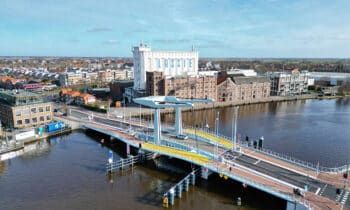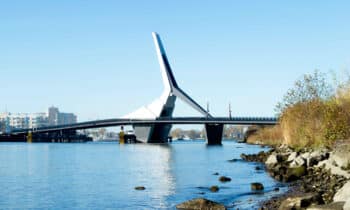
Maintenance of Merwede bridge successfully completed
With lightning-fast recovery methodology
The Merwede Bridge will be replaced in the period 2029-2031 as part of the widening of the A27 between Houten and Hooipolder. Until then, the existing 1961 bascule bridge must remain safe and available to traffic. However, a periodic inspection revealed leaks in the main load-bearing structure of the bridge as well as corrosion on a number of suspension cables (tethers). Reason enough for Rijkswaterstaat to act quickly and look for a specific repair method that would fit the remaining life span of the bridge.
The Merwede Bridge, like all other works of Rijkswaterstaat, is inspected periodically. "So during the last inspection the necessary defects were found, such as flaking preservation on the suspension cables and leaks in the bridge itself," says Menno Kamp, environment manager at Rijkswaterstaat. "At those points where the preservation is missing, rusting occurs, which in turn leads to a material degradation. You then have to wonder whether the tensile strength of the suspension cables is still sufficient." So Rijkswaterstaat's 'Over-Bruggen' team was asked to urgently address these defects.

Effective implementation method
Late last year, the Over-Bridges team conducted additional inspections and tests on the suspension cables. "It quickly became apparent that the tensile strength was still sufficient. The material degradation was not such that we had to shut down the bridge," Kamp continued. "On the other hand, it was necessary to move on quickly and stop further corrosion. Together with Onderhoudscombinatie Sterk (Swarco and Knook Staal en Machinebouw, ed.), which is responsible for the long-term maintenance of the engineering structures in this region, we started brainstorming in early 2023 in a 'construction team-like' construction in order to come up with a very effective implementation method that fits the remaining lifespan and causes as little disruption as possible. Preferably an alternative to re-preserving the suspension cables, as this would require the entire bridge to be scaffolded, causing many stoppages and delays."
Trade-off matrix
So Rijkswaterstaat was looking for a solution to keep the Merwede Bridge safe and available for traffic in the coming years. "To take this on, Rijkswaterstaat and Combinatie Sterk put together a team from both parties that worked together in a construction team to generate solutions," says Arnold den Hoedt, project manager at Knook Steel and Mechanical Engineering. "The beauty of such a construction team is that with a relatively compact team of experts, we were able to go directly into depth. A trade-off matrix was drawn up of four possibilities with three alternatives in addition to the traditional method of preservation. Within two months there was already a concrete implementation proposal down to the detail level and the required implementation slots had also been determined."
First project in the Netherlands
Based on the trade-off matrix, DYWIDAG's cableskin system was chosen, a concept that has already been applied to cable-stayed bridges around the world and now, for the first time, in the Netherlands as well. Den Hoedt: "With this method, where the suspension cables are wrapped from bottom to top with two layers of butyl rubber tape, we can more than guarantee the technical residual life." Kamp adds: "The application process is also lightning fast. Apart from brushing off some loose preservative, no pretreatment is required. And that means much, much less disruption. It is also a cheaper form of preservation.
Initially, we counted on a closure of many weeks, with the bridge closed squarely. With the cableskin technique, we were able to reduce that to a half lane closure for five weekends per direction, so traffic still had access to one lane. That of course makes us as the Department of Public Works very happy."
Not overnight
Although the cableskin technique is used internationally and complies with all European directives, the team did not take any chances. Den Hoedt: "In the preliminary phase, we conducted a number of tests and tested the cableskin technique in practice. Subsequently, the entire bike path was re-constructed, because the plan was to apply the wrapping to the bike path from an aerial platform. The equipment was then neatly matched to those new calculations. Thus, cordoning off a lane was only necessary to ensure the safety of our people, not to carry out the work. Furthermore, based on the practical tests, the necessary improvements were made. For example, the decision was made deliberately not to wrap the highest risk area for corrosion, the bottom 2.5 meters of the suspension cable. That area was traditionally preserved and fitted with improved anti-vandalism caps. The opportunity was also taken to improve the arch bores, or connections of the arches of the bridge to the deck, and the necessary leaks were sealed."
Fast striking power
On the first weekend of September this year, work began energetically outside to repair the Merwede Bridge. Despite the sometimes harsh weather conditions, the work was carried out in just ten weekends. "We look back on a perfectly executed project" thinks Den Hoedt. "The close cooperation between Rijkswaterstaat, Sterk and Knook Staal en Machinebouw has led to a quick hit with concrete solutions and a very positive execution." Kamp can also agree, saying, "We have put our shoulders to the wheel together. What happened here is also very unique by our standards, where we went into the realization together after a relatively short preparation time. Incidentally, the Department of Public Works Major Projects and Maintenance also looked over our shoulders. It recorded a zero situation of the suspension cables prior to the repair work. When the bridge is replaced later, the suspension cables will be reanalyzed so that we can get a picture of how they behaved during the period they were taped in."




